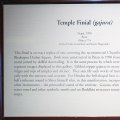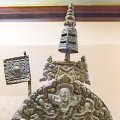Patan Museum (Nepal): photo 203
Photo 203 of 212 in Gallery: Patan Museum (Nepal)

Image title: Thojya technique (repoussé)
Description of the photo
The intended design—here an image of the god Sveta Bhairava—is first drawn on a piece of locally handmade paper called lokta. The drawing is completed in detail to serve as a model during the working process.
The image replicates the fifteen-foot-high, 18th century repoussé (and partially cast) image of Sveta Bhairava located at Hanuman Dhoka. This important image was a donation from Rana Bahadur Shah in 1795 and today still plays an important role during the festival of Indra Jatra when a reservoir of beer is concealed behind it’s mouth from which it is piped to the mouths of the god's devotees.
For quality work, a thick 18-gauge sheet of copper is cut to size and the design drawn on it.
Working from the front on a traditional, floor-mounted anvil (khalu), the artist creates the basic form by following the drawn outline with a rectangular-headed hammer (thoyagu mugah). The sheet is then turned over and the image beaten out from the back—the process which gives the technique its familiar French name, “repoussé” (pushed again), but called thojya in Newari. The process is repeated front to back until the artist is satisfied that he is ready for the next step.
A taffy-like substance called jhau in Newari (la in Nepali) is then concocted by heating a mixture of mustard oil, resin, and brick dust. A board is thickly smeared with this material and the work is embedded in it. The la fills all the hollow space behind the object, dries solid and creates a firm base against which the artist can work without risk of denting the image. Using hammers, dies, and punches the details are roughed in, as shown on the left side of this example. The right side shows the continuing development of the design.
With hammers, fine dies, and punches the artist further refines and finishes all the details of the design. During this process the object remains embedded in the la matrix, as shown in the previous example. By slight warming the solidified matrix is softened and the image easily removed. It is finished with fire gilding, the task of another specialist in a different shop. In this example only the finished right side of the face has been gilded, with 24 carat gold, but of course normally the whole face is gilded.
Gallery information:
The Patan Museum is located on the Durbar square of Patan (Lalitpur/Lalitapura, Kathmandu, Nepal) which is associated Keshav Narayan Chowk (Keshavnarayan)—a form of Lord Vishnu. Being listed as a World Heritage Site, the whole of Durbar square is filled with exquisite temples, sculptures and other ancient structures, of which the ancient history history can be traced to the Malla Kings of Lalitpur. It is an important site for both Buddhism and Hinduism.
Photo details:
High resolution:
Download file
Size: 1.48 MB
Resolution: 1715 x 1595
© Photograph by Gabe Hiemstra.
License: CC BY-NC-ND 4.0

